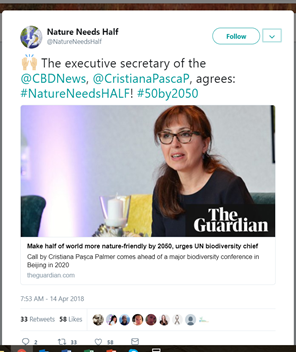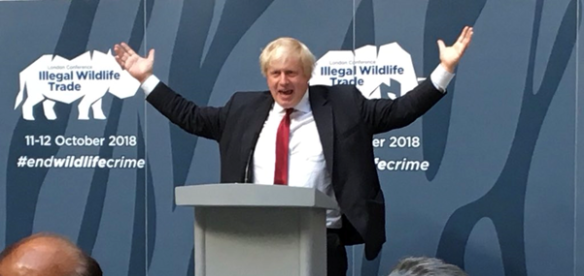A big debate is going on at the moment about the future of conservation – much of it centred on the suggestion by Edward Wilson and others that half the world should be allocated to protected areas. Wilson calls this “Half Earth” (HE), and his book of the same name calls for 50% coverage of ‘inviolable natural reserves’. Others have set out various counter-proposals, including “Whole Earth” (WE) and “Sustainable Half Earth” (SHE). I have played a small part in this debate over the last few months, which has given me the chance to observe at close quarters the strange process by which simple and catchy ideas can take hold, even when most people don’t agree with them. In this article I try to tell this curious tale of HE, SHE, WE and me.
Since its earliest days as a formal movement in the 19th century, conservation’s big idea has been the accumulation of territory into a network of protected areas. As agreed in Aichi Target 11, the current aim is to conserve by 2020 17 per cent of land and 10 per cent of the ocean in protected areas. This is going fairly well – according to the Protected Planet Report 2016, “Just under 15% of the world’s terrestrial and inland waters, just over 10% of the coastal and marine areas within national jurisdiction, and approximately 4% of the global ocean are covered by PAs”. In fact, if all terrestrial protected areas were added together to create one country, it would be the world’s biggest, larger than Russia. Nonetheless, many conservationists have argued that this is not enough, and that new post 2020 targets need to be far more ambitious. But how ambitious? And what kind of protection are we talking about?
Various proposals have been put forward to answer these questions. Two have gained the most attention: Half Earth (mentioned above) and its non-identical twin Nature Needs Half. Both campaigns call for 50% of the planet to be allocated to protected areas, drawing on various ideas from conservation science, particularly island biogeography theory. Where they seem to differ is in the form of protection. Nature Needs Half (which pre-dates Half Earth) talks about new protected areas across the full range of IUCN categories, which range from the super strict to areas where human habitation and sustainable use is allowed. In contrast, Half Earth, at least as set out in E.O. Wilson’s book, seems to be about protection at the stricter end of the scale, although there is insufficient detail to allow certainty about this.
I find the 50% protection concept worrying because it could cause significant human suffering (from displacements and lost livelihood opportunities), because these impacts would create communities hostile to conservation goals, because it perpetuates a spatial and discursive separation of ‘people’ from ‘nature’, and because it ignores the underlying drivers of biodiversity loss (largely driven by industrial capitalism and associated consumption in the developed world). Based on these concerns, some colleagues and I proposed an alternative model (written up in a paper published in Oryx with Bram Büscher as first author), which we called “Whole Earth” (WE). This calls for a more joined up approach to conservation that does not separate the world into ‘nature’ and ‘not nature’ and which takes seriously the challenge of reforming the unsustainable global political economy.
In February this year, I braved the snow to travel to London for the ZSL Space for Nature symposium. This brought together numerous experts and organisations for two days of discussion on the future of protected areas, explicitly positioned as a contribution to the post 2020 process. At the event I participated in a panel debate with, among others, Harvey Locke, the founder and figurehead of the Nature Needs Half campaign. I gave a short presentation, based on our Whole Earth paper, which I called “From Half Earth (HE) to Whole Earth (WE)” (see the grainy shot below). In it I made something of the fact that ‘HE’ is a singular and masculine pronoun, whereas ‘WE’ is plural and gender neutral – rather appropriate for the two different proposals. I firmly believe that most conservationists are closer to WE than HE in their views – whether through ideology (they don’t like the idea of splitting the earth down the middle) or pragmatism (they don’t see any chance of convincing policy makers to agree to half earth).

Credit: Johanna Eklund on Twitter
In the audience at ZSL was Cristiana Paşca Palmer, the Executive Secretary of CBD, who has the unenviable task of supporting all the parties to the convention as they work towards a 2020 agreement. I suspect she liked my HE-WE challenge, because a few weeks later she was giving a plenary talk in Cambridge, in which she presented a new idea – “Sustainable Half Earth (SHE)”. This is her idea for how to make the ‘human half’ of the planet sustainable through stricter environmental regulations on farms and in cities, and curtailment of unsustainable consumption. Paşca Palmer added this to HE and WE from my talk to invent a catchy equation: HE+SHE=WE.

Credit: Chris Sandbrook
HE+SHE=WE is certainly a clever play on acronyms. However, there are two big problems with the equation. First, it implies that Half Earth and Whole Earth are compatible – just add SHE to HE and – hey presto – you get WE! This misunderstands the WE proposal, the whole point of which is to challenge the idea that it is feasible and just to exclude humanity from half the earth. Second, it appears to endorse Half Earth, by including it in the equation. I put this to Paşca-Palmer in Cambridge, and she told me that her idea of Half Earth wasn’t the same as E.O. Wilson’s. She was thinking of a range of protected areas (NNH style), and also lots of restoration areas that might not be protected areas at all. This sounds fine, but when most people will only engage with the superficial equation presented on screen, this kind of nuance will rarely come through.
Unsurprisingly, the CBD’s apparent support for the 50% proposal was picked up in the traditional media and in the Twittersphere. The Guardian wrote an article based on the talk in Cambridge (although showing admirable restraint by not using the HE+SHE=WE equation!), and Nature Needs Half sent out a gleeful celebratory tweet.

Credit: Nature Needs Half on Twitter
What can we learn from all this? For me the main lesson is ‘beware the power of the simple idea’. Jonathan Baillie, of National Geographic, speaking at the ZSL event, emphasised the importance of having a ‘simple common message’ to gain attention and bring about change. But this is no use to conservation if the idea is a bad one! Half Earth is the type example. It is certainly a simple message, and seems to be gaining momentum like an internet meme, foreclosing alternative debates, and convincing sensible people who don’t actually agree with it, like Cristiana Pasca-Palmer, to give it implicit endorsement. As it draws more and more attention, it seems more and more credible – and has even gained the support of populist politicians like Boris Johnson, who spoke with great enthusiasm about it in his speech at a recent reception on Illegal Wildlife Trade in London (see below). Thank goodness he is no longer the UK Foreign Secretary and able to push for it from the heart of government!
Conservation certainly needs to find ways to be relevant and to gain traction with large audiences and powerful people. However, this must not be achieved by creating simplistic, soundbite ideas that do more harm than good.

Credit: UK Foreign Office on Twitter

Less about Boris, more about H L Mencken “For every complex problem there is an answer that is clear, simple, and wrong”. As a layman, I’ll re-read your fine piece before contextualising it for my mixed merry band of followers.
Meanwhile, in the vein https://insideecology.com/2018/08/10/bugbears-bioblitz-buzzard-beaver-and-bat/
Best wishes
Pingback: Evidence-based Half Earth – Ecology is not a dirty word